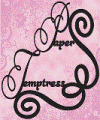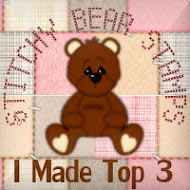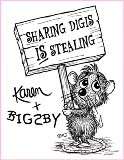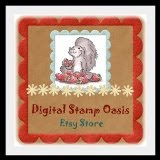WOW, I feel like I am on a roll, lol Not only did I have time to make this tutorial for you, but I also made my first official post on my
Egg Transformer blog. There are other posts on it, but they are all copied from posts I made on this blog. The egg I just posted is the very first egg I designed myself. I'd love it if you could pop by it and let me know what you think.
I was going to make a card today, but the thought occurred to me that a tutorial would be fun. So why not one on paper stitching?!
In my last post, the card has a really pretty paper stitching pattern on it. The stitch used for this pattern is one of many. So far, of the ones I have tried, I like this one the best.
For those who have never tried this technique, I thought I would show you how simple it can be. The first time I tried it, I got very confused. I was sure I would never get the hang of it. I did, though, and I absolutely love it.
I did a lot of "talking" since I was trying to explain it to make sense. I apologize ahead of time if it is to long and boring. I underlined the main points in case you don't have time or the patience to read my rambling (wink) Also, that this is a photo tutorial instead of a video. I haven't figured out how to make videos yet.
AND.....my camera was being incredibly naughty today! I was so close to putting it in time out! Luckily for the camera, I wanted to finish this tutorial first ;o) so the photos are not as good as they could be.
You can click on any of the photos if you need to see the details better.
This is the pattern I used for the last card. I copied it from a paper stitching magazine a while ago. I will add some links to the bottom of the post for sites that offer free patterns for you to try.
* To start, you will need to
cut your paper the same size as the pattern. I find that light weight card stock works best.
*
Adhere the card stock to the back of the pattern with removable tape, such a Dotto
*
Do all the piercing at one time. You will want to make sure to keep the piercer straight (I have no idea what degree the angle would be, maybe 180?) Either way, it should be straight up and down, not held at the angle like when using a pencil.
You will want to make sure you did not miss any holes by holding it up to the light before removing the paper.
***A little about the stitching pattern holes. This is the swirl from the above pattern I chose to use. You will notice right away that the "holes" are not evenly spaced. I have yet to see a pattern where they they are.
On the curve of the left swirl, you will see 2 holes farther apart than the others are. Now, you may be tempted to poke a hole in between to make the spacing more even...but don't do it! LOL It really will mess things up, believe me, I've tried it.
On the curve of the right swirl, you will see that 2 holes are closer to one another. In this pattern it is not so bad, but in others I have done, some were really close. It makes it difficult when stitching and can cause the paper to rip between the holes. TIP: to help prevent tearing from happening, put some scotch tape on the back side of holes that are close together. You can stitch right through the tape and it gives the paper some extra strength.
When all is said and done, the odd spacing of these holes won't even matter in the finished flourish, yeah!
*You will need to know what I call the "hole count". Every pattern tells you the count for it. It will either be on the pattern itself (like this one) or written in instructions that might accompany the pattern. When it is, you will probably want to write it on the pattern itself so you will always know.
The hole count for this pattern is 1-5. That means you will start at hole #1 and end at hole #5, continuing the stitching with this 1-5 numbering. This pattern has the hole count on the bottom center of it. Other patterns have the hole count next to the piercing patterns.
Hole #1 can be on either end of the swirl. If it matters where hole #1 is for a particular pattern, it will tell you.
*Many people use embroidery floss for stitching. When using this, you will want to separate the threads and us only one of them. There are places where you can buy special paper stitching thread in which you most likely will not have to do this (I don't know for sure since I don't have any). But embroidery thread is pretty and much less expensive
*The size needle does matter. It took me a while to find out what size to use. Actually, I never figured it out. I finally found someone I could email and ask, tee he he. Of course, after she replied, I seemed to see the needle information everywhere (rolling eyes) The most commonly used and easiest to find is the #10 embroidery needle. If the needle is to big, it makes the holes in the paper really large when you stitch through them, while on the other hand, if it is to small...it is near impossible to get the thread through it! Even one thread of the embroidery floss is to thick to pull through the eye, if you happen to even get it in the eye, ha ha ha
*After taping the end of the floss to the back, you will go UP hole 1. (The back of the pattern is the side with the big bumps.)
*
Count to the 5th hole and go down. When counting to hole 5, include hole 1. I know...it's kind of obvious! BUT...this actually confused me when I first started. No directions clarified if you counted it or not. This caused me quite a bit of frustration (again rolling my eyes) therefore I figured I would tell you just in case I am not the only one who over thinks things, ha ha ha
*Come
UP hole #6.
*
Count back 5 (including hole 5, tee he he) ,which will bring you to hole #2
and go down. When you get further along, it will not be so easy to see which hole you need. I find, for myself, it is better to keep in the habit of counting even when just beginning.
*
Continue doing the hole count stitching (1-5 here) for the whole pattern unless other wise instructed. You will always come up the hole
next to the one you just came down. You will start restitching in holes but it should not make the hole larger.
If you look underneath, you will find the stitching makes a pattern. At first, before you start stitching into holes already stitched in, you will see that the stitches have a space between them (like on the left/top ones). Once you start to restitch in the holes, the blank spot fills in (like you see on the curve to the right). As you stitch in the "
unprestitched" (ha ha ha, is that even a word?) holes, there will always be this space. When you go through "prestitched" (again, is that even a word?) the blank spot fills in. I know that there are probably more "technical" words I could have used, but I am a simple person, lol
This is good to know because if you keep an eye on this, you will always know when/if you have miscounted somehow. Of course, if you do miscount, you can always take out those stitches and just continue on as if it never happened.
*When you are at the end, your last stitch should be going down.
Tape the floss to the back and cut off the extra. If the last stitch doesn't go down, you have miscounted somewhere.
The last stitch is not always in the very last hole as you can see with this swirl.
LINKS
Card making Inspirations a tutorial for a different type of stitch
*Stores with some free patterns for you to try:
Stitching Cards >>> Link to their free patterns
HERE (awwww...check out the adorable dog! using a SUPER EASY stitch!)
Form-A-Lines >>> Link to their free patterns
HERE
Pin Broidery >>> Link to their free patterns
HERE
Prick n Stitch >>>Has one free pattern
HERE
Card Inspirations >>>Link to their free patterns
HERE
*Free patterns:
Rose
Hearts
Wheelbarrow with flowers
HERE are 5 patterns, including a super pretty corner one
HERE you can down load the pattern in PDF format. Soem have a link to an instruction sheet, others links to a blog, while others are just the pattern with no instructions.
*For these ones, you need to click on the photo you want to look at. If you want to print it, you might have to click on the option button on the lower left:
HERE are some interesting printable patterns. There is a variety of stitching techniques among them. One really nice one I like uses a completely different "hole counting" method, but looks really easy. (very bottom, second from left)
HERE are some more interesting ones to print. Variety varies like the one above. Looks like a few fun ones here.
HERE are lots of pretty frames and borders
HERE are some really great ones. Super pretty swan half way down.
Have fun! HUGS



































































